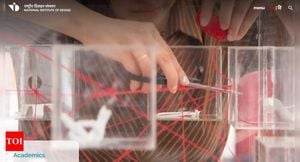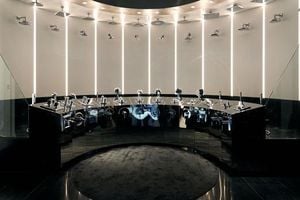As Eid al-Fitr approaches, a cherished tradition among many Muslims is the practice of buying new clothes to wear during the holiday. This custom is not merely about fulfilling a desire; it embodies the etiquette and respect associated with celebrating the day of victory after a month of fasting during Ramadan. According to Agus Aris Munandar, a lecturer at the Faculty of Ushuludin at the Indonesian Islamic University, the clothes worn during Eid al-Fitr symbolize this etiquette. "Initially, wearing neat, new clothes during Eid al-Fitr prayers was a symbol for Muslims returning to fitri after a month of fasting in Ramadan," he explained.
In the tradition of purchasing new clothes, parents often prioritize their children. This practice extends beyond just the prayer service; it also encompasses visits to relatives and friends. Munandar adds, "For adults, new clothes are merely symbolic; the crucial aspect is the renewed intention to practice Islam correctly." This sentiment reflects a broader cultural significance surrounding the attire worn during Eid.
The tradition of buying new clothes for Eid is not a recent phenomenon. According to historical accounts cited by Kompas, this practice dates back to the early 20th century. Snouck Hugronje, a Dutch legislator and advisor to the colonial government, noted in his correspondence during his tenure from 1889 to 1936 that festive celebrations in Indonesia always included special foods, shared meals among family and friends, and the purchase of new clothes. Hugronje wrote, "In every place of celebration, this is always accompanied by special costs, and the usual sacrifices made by relatives and acquaintances, and buying new clothes, with the addition of various forms of entertainment."
Hugronje's observations indicate that the practice of buying new clothes for Eid in Indonesia parallels similar customs observed in Europe during New Year celebrations. Additionally, other historical sources suggest that the tradition of wearing new clothes during Eid can be traced back to the Islamic Mataram kingdom around 1596. Historians Marwati Djoened Poesponegoro and Nugroho Notosusanto documented this in their work titled National Indonesian History.
As the practice evolved, it became intertwined with the concept of prestige and appearance, particularly influenced by advertisements that highlight the allure of new clothing. Hidayat Soerya Abadi from the State Islamic University (UIN) Sunan Ampel points out that the origin of buying new clothes for Lebaran is a tradition that prioritizes appearance. Advertisements often depict new clothing as a form of affection or attention from parents to their children.
Wearing the best clothes during Eid al-Fitr is considered a fundamental aspect of the tradition. The Prophet Muhammad's companion, Hasan bin Ali, is reported to have said, "On every Eid [Eid al-Fitr], the Messenger of Allah (peace and blessings of Allah be upon him) wore the best clothes he had, and wore the best fragrance he had, and sacrificed the most expensive sacrificial animal for the animals that we could afford." This tradition emphasizes the importance of neatness and cleanliness over mere newness.
Importantly, there is no strict requirement to buy new clothes; rather, the focus is on the condition and tidiness of the attire. If someone cannot afford new clothes, wearing clean and well-maintained older garments is still considered appropriate according to religious teachings. Hidayat, the Director of Islamic Religious Affairs and Sharia Guidance at the Ministry of Religion in Indonesia, noted that this tradition is not unique to Indonesia; many Islamic communities worldwide engage in similar practices during Eid.
However, in recent years, the tradition of wearing new clothes for Eid has sparked discussions regarding its economic implications and environmental impact. For families facing financial constraints, the expense of purchasing new clothes can become a significant burden. Originally intended as a joyful expression of celebration, the practice has led to concerns about consumerism overshadowing the spiritual essence of the holiday.
A study published in the Journal of Social Sciences and Humanities explored the culture of consuming Eid clothing in Joboan, Sukorambi, Jember village. Researchers found that the tradition of buying new clothes is closely linked to the lifestyle of Muslims in Indonesia, where social pressures and visual culture play crucial roles in shaping consumer behavior. This trend often diverts attention from the deeper spiritual meanings of Eid, which should ideally foster introspection and community solidarity.
Moreover, the fashion industry, driven by the heightened demand for new clothing during Eid, poses significant environmental challenges. The surge in textile production contributes to waste and ecological concerns. As a result, some individuals are reconsidering how they approach Eid celebrations, opting for more sustainable alternatives such as wearing previously owned garments or engaging in upcycling initiatives.
In addition to the cultural practices surrounding Eid clothing, there are broader discussions within the Muslim community regarding the timing of Ramadan and Eid celebrations. Each year, disagreements arise among Islamic countries about the start of Ramadan, leading to variances in when Eid is celebrated. These disputes often reflect deeper political tensions, as seen historically during events like the Kuwaiti occupation and the differing stances of regimes in Baghdad and Damascus. Such political divisions can exacerbate confusion and dissent among communities.
For instance, Libyan leader Muammar Gaddafi once extended the difference in celebration to two days to avoid aligning with either side of a political dispute, leading the Libyan populace to celebrate Eid separately. Calls for a more scientific approach to determining Ramadan and Eid dates have emerged, advocating for reliance on astronomical calculations instead of traditional lunar sightings. Yet, many religious leaders resist this shift, fearing it could diminish their authority and relevance in decision-making.
This reluctance to embrace scientific methods perpetuates divisions within the Muslim community, as differing interpretations of religious observances can lead to confusion and conflict. Millions of Muslims may find themselves celebrating Eid on different days, resulting in a lack of unity during a time meant for communal celebration and reflection.
Ultimately, the intertwining of cultural, economic, and political factors surrounding the celebration of Eid al-Fitr reflects the complexities of contemporary Muslim identity. As the tradition of buying new clothes continues to evolve, it raises essential questions about the balance between cultural practices and spiritual values. The hope remains that as communities navigate these challenges, they can find a way to honor their traditions while fostering a deeper understanding of the true essence of Eid.






